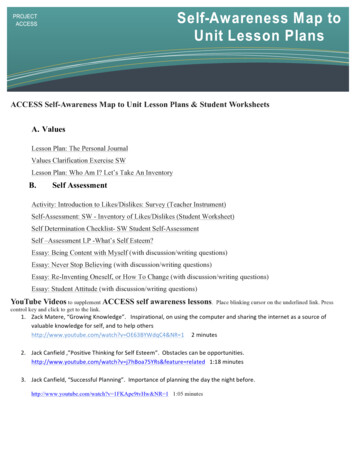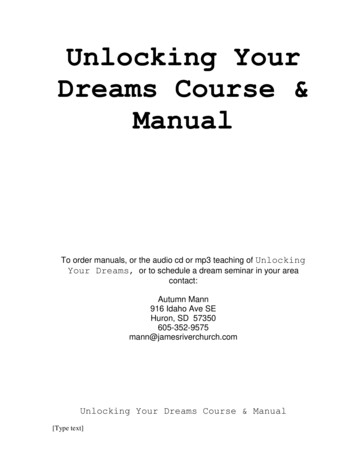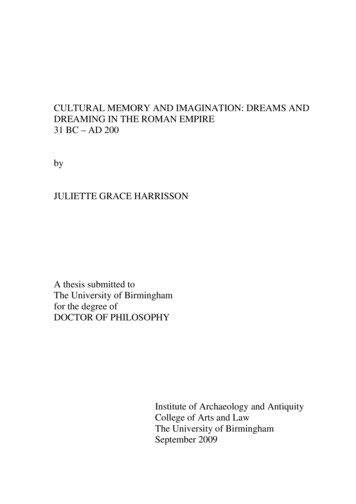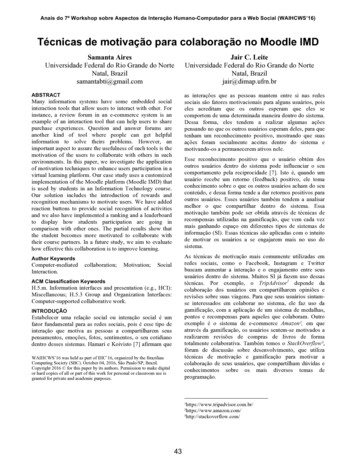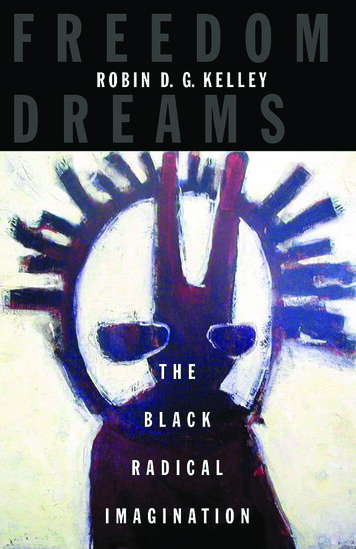
Transcription
Freedom Dreams . . “A powerful book. . . . Robin D. G. Kelley produces histories of black radicalism and visions of the future that defy convention and expectation.”— . ove and imagination may be themost revolutionary impulsesavailable to us, and yet we havefailed to understand their politicalimportance and respect them aspowerful social forces.This history of renegade intellectuals and artists of the African diaspora throughout the twentieth century begins with the premise that thecatalyst for political engagement hasnever been misery, poverty, or oppression. People are drawn to socialmovement because of hope: theirdreams of a new world radically different from the one they inherited.From Aimé Césaire to Paul Robeson to Jayne Cortez, Kelley unearthsfreedom dreams in Africa and ThirdWorld liberation movements, in thehope that Communism had to offer,Lin the imaginative mindscapes ofSurrealism, in the transformative potential of radical feminism, and in thefour-hundred-year-old dream ofreparations for slavery and JimCrow.With Freedom Dreams, Kelley affirms his place as “a major new voiceon the intellectual left” (Frances FoxPiven) and shows us that any seriousmovement toward freedom must begin in the mind.Robin D. G. Kelley, a frequent contributor to the New York Times, isprofessor of history and Africanastudies at New York University andauthor of the award-winning Hammer and Hoe, Race Rebels, and Yo’Mama’s Disfunktional! He lives inNew York City.
When History Sleeps: A Beginning iFREEDOM DREAMS
ii Freedom DreamsOther works by Robin D. G. KelleyThree Strikes: The Fighting Spirit of Labor’s Last Century(with Howard Zinn and Dana Frank)Yo’ Mama’s Disfunktional! Fighting the Culture Wars inUrban AmericaInto the Fire: African Americans since 1970Race Rebels: Culture, Politics, and the Black Working ClassHammer and Hoe: Alabama Communists during theGreat DepressionTo Make Our World Anew: A History of African Americans(coedited with Earl Lewis)
When History Sleeps: A Beginning i i iFREEDOMDREAMSTHEBLACKRADICALIMAGINATIONROBIN D. G. KELLEYBEACON PRESSBOSTON
Beacon Press25 Beacon StreetBoston, Massachusetts 02108-2892www.beacon.orgBeacon Press booksare published under the auspices ofthe Unitarian Universalist Association of Congregations. 2002 by Robin D. G. KelleyAll rights reservedFirst electronic edition 2002Text design by Sara EisenmanComposition by Speedlowe & BooneLibrary of Congress Cataloging-in-Publication DataKelley, Robin D. G.Freedom dreams : the Black radical imagination / Robin D. G. Kelley.p. cm.Includes bibliographical references and index.ISBN 0-8070-0978-4ISBN 0-8070-0976-8 (Hardcover : alk. paper)1. Black power—United States—History. 2. African Americans—Civilrights. 3. Civil rights movements—United States—History. 4. AfricanAmerican arts. 5. Radicalism—United States—History. 6. United States—Race relations—History. 7. African diaspora. I. Title.E185 .K39 2002305.896 073—dc212001007470
When History Sleeps: A Beginning vFor my big sister,Makani Themba NixonAnd in loving memory ofL i s a Y. S u l l i v a n(1961–2001)andJ o e Wo o d , J r.(1964–1999)Three dreamers who do.
This page intentionally left blank
Preface v i iCONTENTSPrefacevii“When History Sleeps”: A Beginning11. Dreams of the New Land132. “The Negro Question”: Red Dreams of Black Liberation363 . “ R o a r i n g f r o m t h e E a s t ” : T h i r d Wo r l d D r e a m i n g604 . “A D a y o f R e c k o n i n g ” : D r e a m s o f R e p a r a t i o n s1105 . “ T h i s B a t t l e f i e l d C a l l e d L i f e ” : B l a c k Fe m i n i s t D r e a m s1356. Keeping It (Sur)real: Dreams of the Marvelous157“ W h e n H i s t o r y Wa k e s ” : A N e w B e g i n n i n g195Sources199Acknowledgments227Index233Credits247
This page intentionally left blank
Preface i xPREFACEFreedom Dreams is a kind of crossroads for me. I spent more thanhalf my life writing about people who tried to change the world,largely because I, too, wanted to change the world. The history ofsocial movements attracted me because of what it might teach usabout our present condition and how we might shape the future.When I first embarked on this work nearly twenty years ago, thepolitical landscape looked much clearer: We needed a revolutionary socialist movement committed to antiracism and antisexism. Buoyed by youthful naïveté, I thought it was very obviousthen. Over time, the subjects of my books as well as my own political experience taught me that things are not what they seemand that the desires, hopes, and intentions of the people whofought for change cannot be easily categorized, contained, or explained. Unfortunately, too often our standards for evaluating social movements pivot around whether or not they “succeeded” inrealizing their visions rather than on the merits or power of the visions themselves. By such a measure, virtually every radicalmovement failed because the basic power relations they soughtto change remain pretty much intact. And yet it is precisely thesealternative visions and dreams that inspire new generations tocontinue to struggle for change.
x PrefaceI had been thinking about these issues when Professor JudithByfield and Ozzie Harris, director of Dartmouth’s Office ofEqual Opportunity and Affirmative Action, asked me to deliverthe Dr. Martin Luther King Jr. lecture at Dartmouth College inJanuary 2000. In many ways, the opportunity to meditate onKing’s legacy and vision brought a lot of these issues to the surface, especially since I was feeling somewhat alienated from thesame old protest politics. What had happened to the dream of liberation that brought many of us to radical movements in the firstplace? What had happened to socialism the way we imagined it?What had happened to our New Eden, our dreams of building anew society? And what had happened to hope and love in ourpolitics? My lecture consisted of a series of reflections on thesequestions, which consequently became Freedom Dreams.Dr. King constantly warned us that we would not be able tobuild a truly liberatory movement without the “strength to love.”In his 1963 book of the same title, he wrote:We Negroes have long dreamed of freedom, but still we are confined in an oppressive prison of segregation and discrimination.Must we respond with bitterness and cynicism? Certainly not,for this will destroy and poison our personalities. . . . To guardourselves from bitterness, we need the vision to see in this generation’s ordeals the opportunity to transfigure both ourselvesand American society. Our present suffering and our nonviolentstruggle to be free may well offer to Western civilization the kindof spiritual dynamic so desperately needed for survival.King’s words became a kind of template for my lecture, indeed,for all of my thinking from that point on. How do we produce avision that enables us to see beyond our immediate ordeals? Howdo we transcend bitterness and cynicism and embrace love,hope, and an all-encompassing dream of freedom, especially inthese rough times?Rough times, indeed. I was putting the final touches on Freedom Dreams the day the World Trade Center went down—a horrible event I witnessed from my bedroom window. And as I sent
Preface x ioff this manuscript to my editor, bombs were raining down on thepeople of Afghanistan and unknown numbers of innocent peoplewere dying, from either weapons of mass destruction or starvation. Violence will only generate more violence; the carnage hasjust begun. Now more than ever, we need the strength to love andto dream. Instead of knee-jerk flag-waving and submission to anyact of repression in the name of “national interests,” the nationought to consider King’s vision and take a cue from the movement that proved to be the source of his most fertile ideas. Thecivil rights movement demanded freedom for all and believedthat it had to win through love and moral suasion. Those committed to the philosophy of nonviolence saw their suffering as redemptive. The very heart of the movement, the extraordinarySouthern black folks who stood nobly in the face of police dogsand water canon and white mobs and worked as hard as theycould to love their enemy were poised to become the soul of asoulless nation, according to Dr. King. Imagine if that soul wereto win out, if the movement’s vision of freedom were completelyto envelope the nation’s political culture. If this were the case,then the pervasive consumerism and materialism and the starkinequalities that have come to characterize modern life underglobal capitalism could not possibly represent freedom. And yet,freedom today is practically a synonym for free enterprise.Perhaps I’ll be labeled a traitor for saying this, but we are not yetcompletely free. U.S. democracy has not always embraced everyone and we have a long history to prove it, from slavery and “Indian wars” to the 2000 presidential elections. Indeed, the marginal and excluded have done the most to make democracy workin America. And some of the radical movements I write about inthe pages that follow have done awful things in the name of liberation, often under the premise that the ends justify the means.Communists, black nationalists, Third World liberation movements—all left us stimulating and even visionary sketches of whatthe future could be, but they have also been complicit in acts ofviolence and oppression, through either their actions or their silence. No one’s hands are completely clean.
xii PrefaceAnd yet to write another book that either drones on about howoppressed we are or merely chronicles the crimes of radicalmovements doesn’t seem very useful. I conceived FreedomDreams as a preliminary effort to recover ideas—visions fashioned mainly by those marginalized black activists who proposeda different way out of our constrictions. I’m not suggesting wewholly embrace their ideas or strategies as the foundation for newmovements; on the contrary, my main point is that we must tapthe well of our own collective imaginations, that we do what earlier generations have done: dream.Trying to envision “somewhere in advance of nowhere,” aspoet Jayne Cortez puts it, is an extremely difficult task, yet it is amatter of great urgency. Without new visions we don’t know whatto build, only what to knock down. We not only end up confused,rudderless, and cynical, but we forget that making a revolution isnot a series of clever maneuvers and tactics but a process that canand must transform us.
When History Sleeps: A Beginning 1“W H E N H I S T O R Y S L E E P S”:A BEGINNINGWhen history sleeps, it speaks in dreams: on the brow of thesleeping people, the poem is a constellation of blood. . . .Octavio Paz, “Toward the Poem”My mother has a tendency to dream out loud. I think it has something to do with her regular morning meditation. In the quietdarkness of her bedroom her third eye opens onto a new world, abeautiful light-filled place as peaceful as her state of mind. Shenever had to utter a word to describe her inner peace; like morning sunlight, it radiated out to everyone in her presence. Mymother knows this, which is why for the past two decades she hastaken the name Ananda (“bliss”). Her other two eyes never let herforget where we lived. The cops, drug dealers, social workers, therusty tapwater, roaches and rodents, the urine-scented hallways,and the piles of garbage were constant reminders that our worldbegan and ended in a battered Harlem/Washington Heights tenement apartment on 157th and Amsterdam.Yet she would not allow us to live as victims. Instead, we were afamily of caretakers who inherited this earth. We were expectedto help any living creature in need, even if that meant giving up
2 Freedom Dreamsour last piece of bread. Strange, needy people always passedthrough our house, occasionally staying for long stretches oftime. (My mom once helped me bring home a New York City pigeon with a broken leg in a failed effort to nurse her back tohealth!) We were expected to stand apart from the crowd and befriend the misfits, to embrace the kids who stuttered, smelledbad, or had holes in their clothes. My mother taught us that theMarvelous was free—in the patterns of a stray bird feather, in aHudson River sunset, in the view from our fire escape, in the stories she told us, in the way she sang Gershwin’s “Summertime,”in a curbside rainbow created by the alchemy of motor oil andwater from an open hydrant. She simply wanted us to livethrough our third eyes, to see life as possibility. She wanted us toimagine a world free of patriarchy, a world where gender and sexual relations could be reconstructed. She wanted us to see the poetic and prophetic in the richness of our daily lives. She wantedus to visualize a more expansive, fluid, “cosmos-politan” definition of blackness, to teach us that we are not merely inheritors ofa culture but its makers.So with her eyes wide open my mother dreamed and dreamedsome more, describing what life could be for us. She wasn’t talking about a postmortem world, some kind of heaven or afterlife;and she was not speaking of reincarnation (which she believes in,by the way). She dreamed of land, a spacious house, fresh air, organic food, and endless meadows without boundaries, free of eviland violence, free of toxins and environmental hazards, free ofpoverty, racism, and sexism . . . just free. She never talked abouthow we might create such a world, nor had she connected her vision to any political ideology. But she convinced my siblings andme that change is possible and that we didn’t have to be stuckthere forever.The idea that we could possibly go somewhere that exists onlyin our imaginations—that is, “nowhere”—is the classic definition of utopia. Call me utopian, but I inherited my mother’s belief that the map to a new world is in the imagination, in what wesee in our third eyes rather than in the desolation that surrounds
“When History Sleeps”: A Beginning 3us. Now that I look back with hindsight, my writing and the kindof politics to which I’ve been drawn have more to do with imagining a different future than being pissed off about the present.Not that I haven’t been angry, frustrated, and critical of the misery created by race, gender, and class oppression—past and present. That goes without saying. My point is that the dream of a newworld, my mother’s dream, was the catalyst for my own politicalengagement. I came to black nationalism filled with idealisticdreams of a communal society free of all oppressions, a worldwhere we owned the land and shared the wealth and white folkswere out of sight and out of mind. It was what I imagined precolonial Africa to be. Sure, I was naive, still in my teens, but myimaginary portrait, derived from the writings of Cheikh AntaDiop, Chancellor Williams, Julius Nyerere, Kwame Nkrumah,Kwame Ture, and others, gave me a sense of hope and possibilityof what a postcolonial Africa could look like.Very quickly, I learned that the old past wasn’t as glorious,peaceful, or communal as I had thought—though I still believethat it was many times better than what we found when we got tothe Americas. The stories from the former colonies—whetherMobutu’s Zaire, Amin’s Uganda, or Forbes Burnham’s Guyana—dashed most of my expectations about what it would take toachieve real freedom. In college, like all the other neophyte revolutionaries influenced by events in southern Africa, El Salvadorand Nicaragua, Cuba and Grenada, I studied Third World liberation movements and postemancipation societies in the hope ofdiscovering different visions of freedom born out of the circumstances of struggle. I looked in vain for glimmers of a new society,in the “liberated zones” of Portugal’s African colonies during thewars of independence, in Maurice Bishop’s “New Jewel” movement in Grenada, in Guyana’s tragically short-lived nineteenthcentury communal villages, in the brief moment when strikingworkers of Congo-Brazzaville momentarily seized state powerand were poised to establish Africa’s first workers’ state. Granted,all these movements crashed against the rocks, wrecked by various internal and external forces, but they left behind at least some
4 Freedom Dreamskind of vision, however fragmented or incomplete, of what theywanted their world to look like.Like most of my comrades active in the early days of the Reagan era, I turned to Marxism for the same reasons I looked to theThird World. The misery of the proletariat (lumpen and otherwise) proved less interesting and less urgent than the promise ofrevolution. I was attracted to “small c” communism because, intheory, it sought to harness technology to solve human needs,give us less work and more leisure, and free us all to create, invent, explore, love, relax, and enjoy life without want of the basicnecessities of life. My big sister Makani and I used to preach toothers about the end of money; the withering away of poverty,property, and the state; and the destruction of the material basisfor racism and patriarchy. I fell in love with the young Marx ofThe German Ideology and The Communist Manifesto, the visionary Marx who predicted the abolition of all exploitative institutions. I followed young Marx, via the late English historian Edward P. Thompson, to those romantic renegade socialists likeWilliam Morris who wanted to break with all vestiges of capitalist production and rationalization. Morris was less concernedwith socialist efficiency than with transforming social relationsand constructing new, free, democratic communities built on, asThompson put it, “the ethic of cooperation, the energies of love.”There are very few contemporary political spaces where theenergies of love and imagination are understood and respected aspowerful social forces. The socialists, utopian and scientific, hadlittle to say about this, so my search for an even more elaborate,complete dream of freedom forced me to take a more imaginative turn. Thanks to many wonderful chance encounters withFranklin and Penelope Rosemont, Ted Joans, Laura Corsiglia,and Jayne Cortez, I discovered surrealism, not so much in thewritings and doings of André Breton or Louis Aragon or otherleaders of the surrealist movement that emerged in Paris afterWorld War I, but under my nose, so to speak, buried in the rich,black soil of Afrodiasporic culture. In it I found a most miraculous weapon with no birth date, no expiration date, no trademark.
“When History Sleeps”: A Beginning 5I traced the Marvelous from the ancient practices of Maroon societies and shamanism back to the future, to the metropoles ofEurope, to the blues people of North America, to the colonizedand semicolonized world that produced the likes of Aimé andSuzanne Césaire and Wifredo Lam. The surrealists not onlytaught me that any serious motion toward freedom must begin inthe mind, but they have also given us some of the most imaginative, expansive, and playful dreams of a new world I have everknown. Contrary to popular belief, surrealism is not an aestheticdoctrine but an international revolutionary movement concerned with the emancipation of thought. According to theChicago Surrealist Group,Surrealism is the exaltation of freedom, revolt, imagination andlove. . . . Its basic aim is to lessen and eventually to completelyresolve the contradiction between everyday life and our wildestdreams. By definition subversive, surrealist thought and actionare intended not only to discredit and destroy the forces of repression, but also to emancipate desire and supply it with newpoetic weapons. . . . Beginning with the abolition of imaginativeslavery, it advances to the creation of a free society in whicheveryone will be a poet—a society in which everyone will beable to develop his or her potentialities fully and freely.Members of the Surrealist Group in Madrid, for example, seetheir work as an intervention in life rather than literature, a protracted battle against all forms of oppression that aims to replace“suspicion, fear and anger with curiosity, adventure and desire”and “a model space for collective living—a space from whichseparation and isolation are banished forever.”The surrealists are talking about total transformation of society,not just granting aggrieved populations greater political and economic power. They are speaking of new social relationships, newways of living and interacting, new attitudes toward work andleisure and community. In this respect, they share much with radical feminists whose revolutionary vision extended into every aspect of social life. Radical feminists taught us that there is nothing
6 Freedom Dreamsnatural or inevitable about gender roles, male dominance, theoverrepresentation of men in positions of power, or the tendencyof men to use violence as a means to resolve conflict. Radicalfeminists of color, in particular, reveal how race, gender, andclass work in tandem to subordinate most of society while complicating easy notions of universal sisterhood or biological arguments that establish men as the universal enemy. Like all theother movements that caught my attention, radical feminism, aswell as the ideas emerging out of the lesbian and gay movements,proved attractive not simply for their critiques of patriarchy butfor their freedom dreams. The work of these movements taken asa whole interrogates what is “normal”; shows us how the state andofficial culture polices our behavior with regard to sexuality, gender roles, and social relationships; and encourages us to constructa politics rooted in desire.Black intellectuals associated with each of these movementsnot only imagined a different future, but in many instances theiremancipatory vision proved more radical and inclusive than whattheir compatriots proposed.* Indeed, throughout the book I argue that these renegade black intellectuals/activists/artists challenged and reshaped communism, surrealism, and radical feminism, and in so doing produced brilliant theoretical insights thatmight have pushed these movements in new directions. In mostcases, however, the critical visions of black radicals were held atbay, if not completely marginalized. Of course, there are manypeople still struggling to realize these dreams—extending, elaborating, and refining their vision as the battle wears on. This book*Let me emphasize that I am interested in black people’s dreams of the new society. Afascinating book by William H. Pease and Jane Pease, Black Utopia: Negro Communal Experiments in America, looks at white abolitionist and liberal designs for blackcommunities whose main goal was to “train the Negro for complete freedom” (p. 19).Freedom was defined according to Jeffersonian values, determined of course by thewhite architects of these Negro villages. While most communal societies were socialist or communist oriented, the settlements created for black people centered on enterprise, thrift, and individual accumulation—in short, their goal was to instill exslaves with middle-class capitalist values in order to prepare them to be productivemembers of the mainstream. Black people in their study are largely objects of whiteliberal ideology, not agents pursuing their own vision of freedom.
“When History Sleeps”: A Beginning 7is about those dreams of freedom; it is merely a brief, idiosyncratic outline of a history of black radical imagination in thetwentieth century. I don’t pretend to have written anything approaching a movement history or an intellectual history, and Iam not interested in explaining why these dreams of revolutionhave not succeeded (yet!). Rather, I simply want to explore thedifferent ways self-proclaimed renegades imagined life after therevolution and where their ideas came from. Although FreedomDreams is no memoir, it is a very personal book. It is loosely organized around my own political journey, around the dreams Ionce shared or still share—from the dreams of an African utopiato the surreal world of our imagination, from the communist andfeminist dreams of abolishing all forms of exploitation to the fourhundred-year-old dream of payback for slavery and Jim Crow.My purpose in writing this book is simply to reopen a very oldconversation about what kind of world we want to struggle for.I’m not the only one interested in the work of dreaming—obviously there are many activists and thinkers having this conversation right now, ranging from my sister Makani Themba-Nixon,Cornel West, and Lian and Eric Mann to Cleveland’s NormaJean Freeman and Don Freeman, Newark’s Amina and AmiriBaraka, and Detroit’s Grace Lee Boggs, to name but a few. Fordecades, these and other folks have dared to talk openly of revolution and dream of a new society, sometimes creating culturalworks that enable communities to envision what’s possible withcollective action, personal self-transformation, and will.I did not write this book for those traditional leftists who havetraded in their dreams for orthodoxy and sectarianism. Most ofthose folks are hopeless, I’m sad to say. And they will be the firstto dismiss this book as utopian, idealistic, and romantic. Instead,I wrote it for anyone bold enough still to dream, especially youngpeople who are growing up in what critic Henry Giroux perceptively calls “the culture of cynicism”—young people whosedreams have been utterly coopted by the marketplace. In a worldwhere so many youth believe that “getting paid” and living ostentatiously was the goal of the black freedom movement, there
8 Freedom Dreamsis little space to even discuss building a radical democratic publicculture. Too many young people really believe that this is the bestwe can do. Young faces, however, have been popping up enmasse at the antiglobalization demonstrations beginning in Seattle in 1999, and the success of the college antisweatshop campaign No Sweat owes much of its success to a growing number ofradicalized students. The Black Radical Congress, launched in1997, has attracted hundreds of activists under age twenty-five,and so has the campaign to free Mumia Abu-Jamal. So there ishope.The question remains: What are today’s young activists dreaming about? We know what they are fighting against, but what arethey fighting for? These are crucial questions, for one of the basicpremises of this book is that the most powerful, visionary dreamsof a new society don’t come from little think tanks of smart people or out of the atomized, individualistic world of consumer capitalism where raging against the status quo is simply the hip thingto do. Revolutionary dreams erupt out of political engagement;collective social movements are incubators of new knowledge.While this may seem obvious, I am increasingly surrounded bywell-meaning students who want to be activists but exhibit anxiety about doing intellectual work. They often differentiate thetwo, positioning activism and intellectual work as inherently incompatible. They speak of the “real” world as some concretewilderness overrun with violence and despair, and the universityas if it were some sanitized sanctuary distant from actual people’slives and struggles. At the other extreme, I have had students argue that the problems facing “real people” today can be solved bymerely bridging the gap between our superior knowledge andpeople outside the ivy walls who simply do not have access to thatknowledge. Unwitting advocates of a kind of “talented tenth” ideology of racial uplift, their stated goal is to “reach the people”with more “accessible” knowledge, to carry back to the ’hood theinformation folks need to liberate themselves. While it is heartening to see young people excited about learning and cognizantof the political implications of knowledge, it worries me when
“When History Sleeps”: A Beginning 9they believe that simply “droppin’ science” on the people willgenerate new, liberatory social movements.I am convinced that the opposite is true: Social movementsgenerate new knowledge, new theories, new questions. The mostradical ideas often grow out of a concrete intellectual engagement with the problems of aggrieved populations confrontingsystems of oppression. For example, the academic study of racehas always been inextricably intertwined with political struggles.Just as imperialism, colonialism, and post-Reconstruction redemption politics created the intellectual ground for Social Darwinism and other manifestations of scientific racism, the struggleagainst racism generated cultural relativist and social constructionist scholarship on race. The great works by W. E. B. Du Bois,Franz Boas, Oliver Cox, and many others were invariably shapedby social movements as well as social crises such as the proliferation of lynching and the rise of fascism. Similarly, gender analysiswas brought to us by the feminist movement, not simply by the individual genius of the Grimke sisters or Anna Julia Cooper, Simone de Beauvoir, or Audre Lorde. Thinking on gender and thepossibility of transformation evolved largely in relationship to social struggle.Progressive social movements do not simply produce statisticsand narratives of oppression; rather, the best ones do what greatpoetry always does: transport us to another place, compel us to relive horrors and, more importantly, enable us to imagine a newsociety. We must remember that the conditions and the very existence of social movements enable participants to imagine something different, to realize that things need not always be this way.It is that imagination, that effort to see the future in the present,that I shall call “poetry” or “poetic knowledge.” I take my leadfrom Aimé Césaire’s great essay “Poetry and Knowledge,” firstpublished in 1945. Opening with the simple but provocativeproposition that “Poetic knowledge is born in the great silence ofscientific knowledge,” he then demonstrates why poetry is theonly way to achieve the kind of knowledge we need to move beyond the world’s crises. “What presides over the poem,” he wri
5. “This Battlefield Called Life”: Black Feminist Dreams 135 6. Keeping It (Sur)real: Dreams of the Marvelous 157 “When History Wakes”: A New Beginning 195 Sources
